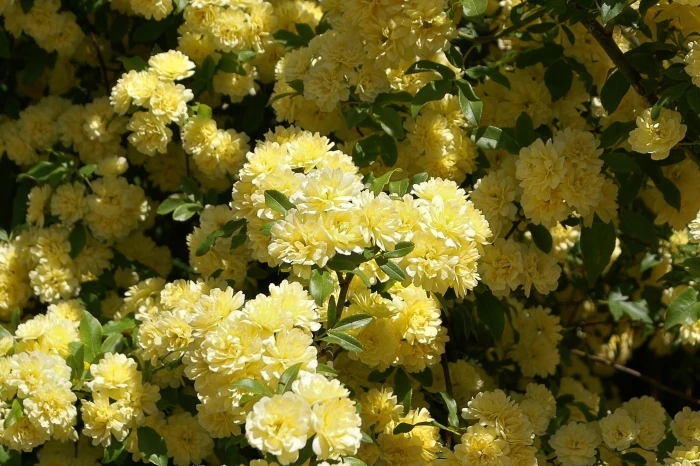Lady Banks’ Rose
(Rosa banksiae)
Lady Banks’ Rose (Rosa banksiae)
/
/

Cette photo a été prise par André ALLIOT.
CC0
Image By:
Cette photo a été prise par André ALLIOT.
Recorded By:
Copyright:
CC0
Copyright Notice:
Photo by: Cette photo a été prise par André ALLIOT. | License Type: CC0 | License URL: http://creativecommons.org/publicdomain/zero/1.0/deed.en | Uploader: Andreal90 | Publisher: Wikimedia Commons | Title: Rosa_banksiae_var._banksiae_Aiton.jpg | Notes: Rosa banksiae, sect. Banksianae. Real Jardín Botánico, Madrid, abril 1988, A. Barra.[[Category:Rosa]] |
























Estimated Native Range
Climate Requirements for Aspen Hill, Maryland
| This Plant | Your Site | Plant Suitability for Your Location | ||
|---|---|---|---|---|
| • Precipitation | 15" - 68" | 43" | Aquatic | Aquatic |
| • High Temp. | 49°F - 93°F | 87°F | Your summer temperatures are normal for this plant. | Excellent |
| • Low Temp. | 6°F - 42°F | 24°F | Your winter temperatures are normal for this plant | Excellent |
This plant should grow very well at your location without additional irrigation.
Summary
Rosa banksiae, commonly known as Lady Banks’ rose, is a deciduous to semi-evergreen scrambling shrub or vine native to riverbanks and mountain slopes in central and western China. It can grow vigorously to 6 m (20 ft) tall and wide, with long, slender branches that are practically thornless, though some prickles up to 5 mm long may be present on stout shoots. The flowers are small, 1.5–2.5 cm in diameter, white or pale yellow, and fragrant, resembling the scent of violets. Lady Banks’ rose is one of the earliest flowering roses, typically blooming in May in the northern hemisphere, although cold weather can delay flowering.
This rose is valued for its mass of spring flowers, nearly thornless nature, and ability to cover structures quickly, making it ideal for use on trellises, arbors, fences, and as a ground cover in large areas. It is also used in heritage and cottage gardens. Lady Banks’ rose thrives in full sun to partial shade, requires medium amounts of water, and prefers well-drained soils. While generally low-maintenance, it can become quite large and may require pruning to keep it in bounds. It is resistant to many of the common rose diseases but can be susceptible to aphids and scale insects.CC BY-SA 4.0
This rose is valued for its mass of spring flowers, nearly thornless nature, and ability to cover structures quickly, making it ideal for use on trellises, arbors, fences, and as a ground cover in large areas. It is also used in heritage and cottage gardens. Lady Banks’ rose thrives in full sun to partial shade, requires medium amounts of water, and prefers well-drained soils. While generally low-maintenance, it can become quite large and may require pruning to keep it in bounds. It is resistant to many of the common rose diseases but can be susceptible to aphids and scale insects.CC BY-SA 4.0
Plant Description
- Plant Type: Shrub, Vine
- Height: 15-20 feet
- Width: 6-10 feet
- Growth Rate: Rapid
- Flower Color: White, Yellow
- Flowering Season: Spring
- Leaf Retention: Evergreen
Growth Requirements
- Sun: Full Sun, Part Shade
- Water: Medium
- Drainage: Medium, Fast
Common Uses
Bee Garden, Bird Garden, Butterfly Garden, Deer Resistant, Drought Tolerant, Fragrant, Groundcover, Hedges, Salt Tolerant, Showy Flowers
Natural Habitat
Riverbanks and mountain slopes in central and western China
Other Names
Common Names: Banks’ rose
Scientific Names: Rosa banksiae, Rosa banksiana, Rosa inermis, Rosa banksiae var. albo-plena, Rosa fragariiflora
GBIF Accepted Name: Rosa banksiae R.Br. ex Aiton